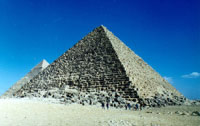|
The Pyramid of
Menkaure
 The evidence
from Menkaure's pyramid further supports this conclusion. As
already stated Petrie gave the angle of slope of Menkaure's pyramid
as 51°
+/- 10'; whilst the figures from I. E. S. Edwards suggest an
angle of 50°- 43'. The nearest equivalent seked to 51ø
is 5.75 which equals 50°- 36' or 5.5 which equals 51°- 51'. The evidence
from Menkaure's pyramid further supports this conclusion. As
already stated Petrie gave the angle of slope of Menkaure's pyramid
as 51°
+/- 10'; whilst the figures from I. E. S. Edwards suggest an
angle of 50°- 43'. The nearest equivalent seked to 51ø
is 5.75 which equals 50°- 36' or 5.5 which equals 51°- 51'.
Mark Lehner in his book The Complete Pyramids
suggests that the base of Menkaure's pyramid is not square measuring
343 feet on one side and 335 feet on the other. If these figures
are correct and the Egyptians built to a whole number of cubits
then the longer side was probably based on 200 cubits and the
shorter on 195 cubits. Applied to the pyramid this would give
two angles of slope; one of 51.85° and the other of 51.19°.
If these measurements are correct two different sekeds would
have to have been used.
If the same idea, for the Northern Stone
Pyramid of Sneferu, is applied to the pyramid of Menkaure, using
a 5/7 seked ratio, then the angle of slope could be shown to
be 4.00 sekeds which gives an angle of slope of 51.34° (51°
- 20' - 25"). If this seked is correct then the height to
base ratio is 5 to 8 for one of the angles of slope. Unfortunately
this ratio does not easily fit to the other angle of slope which
has a ratio of 7:11. This becomes apparent when the measures
are converted to cubits.
As already states the longer side of 343
feet gives a length of almost exactly 200 cubits. This figure
is divisible by 8 (200 / 8 = 25) and would give a theoretical
height for the pyramid of 125 cubits. The shorter side would
appear to be 195 cubits but in this case the number is not easily
divisible by 11 (195 / 11 = 17.727), nor is the height of 125
cubits readily divisible by 7.
We might conclude that either the present
measurements have not been determined with sufficient accuracy
to draw conclusions or the builders failed to make the sides
of this pyramid equal through faulty measurement. Because of
the problems generated by two separate sekeds derived from a
rectangular base it is very unlikely that an inaccurate ground
plan could have gone un-noticed in the early stages of construction
and not have been corrected. This suggests that, if the sides
were not originally intended to be equal, then two separate sekeds
were a deliberate aspect of the design. What these might have
been cannot be easily determined.
Summary
Whilst the use of the seked, as indicated
in RMP, can be clearly perceived in the design of a number of
pyramids it cannot be conclusively shown to have been used in
all. It is most likely that variations were used for specific
reasons. With very few exceptions the ratios do not fit with
basic building practice which would normally prefer to work with
primary palm ratios such as 7 to 5. Instead we find the use of
part palm ratios in almost all known pyramids. The only conclusion
is that the symbolism of the ratio was more important than the
ease of building practice. As has been demonstrated sekeds of
5.25 and 5.5 incorporate the 3 : 4 : 5 triangle and a relationship
to circle respectively. It is therefore likely that it was these
symbolic or cultic aspects that were deemed to be important in
the design of the pyramids.
Notes:
1. Reading the Past: Mathematics and Measurement O.A.W. Dilke
British Museum Press 1987
2. Mathematics in the Time of the Pharaohs Richard Gillings.
Dover (NY) 1972
3. The Pyramids of Egypt I. E. S. Edwards. Ebury Press 1947
4. The Pyramids and Temples of Gizeh William Flinders Petrie.
Field and Tuer 1883
5. The Pyramids Complete Mark Lehner. Thames and Hudson 1997
6. Mathematics in the Time of the Pharaohs Richard Gillings.
Dover (NY) 1972
7. Mathematics in the Time of the Pharaohs Richard Gillings.
Dover (NY) 1972
8. Egyptian Pyramids Leslie Grinsell John Bellows 1947
-
Other links articles:
-
Abydos - Temple mysteries
-
Egypt tour : Eleven
day tour in April 2005 and in November 2005
- The Keys to the
Temple - Mystery patterns in the British landscape showing pyramid
geometry.
- Site Map - List of all David Furlong's articles.

Full article download
 or text only article
or text only article

Page 1,
2, 3,
4, 5,
6 |

